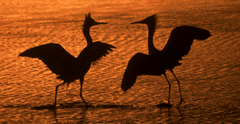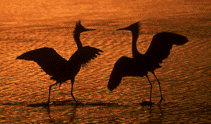|
BIRDS AS ART ON-LINE BULLETIN #36, NOVEMBER 14, 2000
BIRDS AS ART/INSTRUCTIONAL PHOTO-TOUR VACANCIES, CANON LENS SPECIALS FROM HUNT'S
MORE ON THE CANON EOS 1v AND THE NIKON 80-400 VR LENS
Due to cancellations, there is now one opening on the 3-DAY
FEB 10-12 Southwest Florida IPT and one opening on the 4-DAY Southern
California IPT (with an option to expand to a 6-DAY). See the web
site for details, and do call before purchasing your plane tickets to make
sure that the slot that you want is still open. Both of these IPTs sold
out within days of being announced.
Hunt's Photo in Boston (1-800-924-8682) is offering the prices
below only to BIRDS AS ART/Bulletin subscribers. They
are in effect only until November 25, 2000. Please ask for either
Will or Lisa and do mention BIRDS AS ART.
Canon Elan 7E $503.99
Elan 7 Body $451.99
Eos 3 Body $899.99
Eos 1V Body $1649.99
Eos 1V HS $1899.99
Eos D30 Digital body $2999.99
BG-ED3 battery grip (for D30) $149.99
IBM 340mb Microdrive $260.99
EF 300mm F4L IS USM $1299.99
EF 300mm F2.8L IS USM $4599.99
EF 500mm F4L IS USM $6699.99
EF 400mm F2.8L IS USM $7899.99
EF 600mm F4 L IS USM $8899.99
EF 17-35mm F2.8L USM $1249.99
EF 28-70mm F2.8L USM $1149.99
EF 70-200mm F2.8L USM $1249.99
EF 100-400mm F4.5-5.6L IS USM $1499.99
EF 2X Tele Extender $319.99
EF 1.4X Tele Extender $389.99
MORE ON THE NIKON 80-400mm VR LENS
From subscriber Pat Price who is a fine photographer and
frequent IPT participant:
Hi Arthur,
Just thought I would contribute my perspective on the new
Nikon 80-400 VR lens.
As you know, I have been shooting primarily Nikon equipment
for a long time but found myself carrying the Canon EOS-3 and the Canon 100-400
IS lens as a "second camera" for flight shots and other moving targets that the
Canon 100-400 is just perfect for. I did this simply because Nikon did not have
an equivalent lens that offered the versatility that Canon does in a
lightweight, image stabilized lens.
I was really looking forward to the new Nikon 80-400 VR lens
with the expectation that I would be able to travel with one manufacturer's
equipment and simplify my life. Since I am now shooting with the Nikon D1, I was
looking forward to the benefit of the additional focal length benefit built into
the digital format. The 80-400 VR lens becomes a 120-600 mm VR lens that you can
hand hold. Now that is a powerful combination.
I received the Nikon 80-400 VR lens early last week. Moose
Peterson and I were shooting together this past weekend at Bolsa Chica so I had
a chance to give the new lens a workout in real field conditions photographing
flying brown pelicans, flying egrets and flying great blue herons.
My verdict, based on in field use of both lenses, is that the
Canon 100-400 IS lens is a superior lens to the Nikon 80-400 VR lens for the
following reason.
The Canon lens is a push-pull zoom that works smoothly and can
easily be zoomed while panning for flight shots to improve framing without
losing the subject in the viewfinder. The Nikon lens is a "turn" zoom that is
very stiff and can not be zoomed from 80-400 without shifting your grip on the
lens at least once. This makes it very difficult (impossible for those of us
less skilled) to zoom the lens on a flying bird and keep the subject in the
viewfinder.
Considering you can purchase an Elan II and the Canon 100-400
IS for about the cost of the Nikon 80-400 VR lens, Canon is a better way to go
in my humble opinion.
I will stick with Nikon because of the fantastic metering in
the F5 and the D1. I also have had fewer in field problems with the Nikon bodies
than I have the Canon Elan II and the EOS-3, particularly in harsh cold
conditions (Alaska winters). My EOS-3 body looses its electrical connection to
the battery regularly when the temperature gets close to zero and I have to take
the battery out and warm it up to get it to make contact again. I have had
similar problems with the Elan II battery shrinking away from the contacts when
it gets cold. I haven't had this problem with Nikon equipment.
I will be carrying the Canon Elan II and the Canon 100-400 IS
lens along with my assortment of Nikon gear simply because Nikon has not yet
been able to offer an acceptable equivalent.
I am sharing this with you as one person's
opinion.
Your friend from the west,
Pat Price
And Pat's response to my questions:
Hi Arthur,
You are most welcome to use my comments regarding Canon and Nikon equipment
experiences that I have related to you. If you want to disclose my name, that is
fine with me.
I remembered after I sent you the first E-mail that I did forget to mention
"initial focus acquisition" and tracking with the Nikon 80-400 VR
lens. The Nikon lens is exceptionally slow at initial image acquisition.
Unless the lens is prefocused to the approximate flight path of a bird (sic:
camera to subject distance), it will not lock on. The lens is not even in the
same league as the Canon 100-400, even with the Elan II body when it comes to
the speed of initial focus acquisition.
Image tracking with the Nikon lens is not as fast as the Canon so if the
subject is flying at camera, the Nikon lens is a distant second to the Canon.
With horizontal flight of the pelicans and egrets I was shooting, I really did
not notice any shortcomings in the Nikon lens after I locked on provided I did
not try to zoom the lens for reasons I described previously.
You asked about the EOS 3 performance for flight shooting. Aside from the
meter which I have trained myself to mostly ignore, the EOS 3 is on a par with
the F5 for tracking birds in flight. I can not say that I have noticed a real
difference in either the speed of initial focus acquisition or
tracking accuracy between the two bodies. Now with birds flying at
camera I would have to give an edge to Nikon and the silent wave lenses versus
Canon EOS 3 and the 100-400 IS lens. I seem to get more keepers in that
situation with Nikon.
You asked if switching between Canon and Nikon was a problem for me. Like
anything else, with enough practice, it is no big deal. I find there is about as
much difference moving between the F5 and the D1 as there is between Canon and
Nikon. As Moose says, the equipment is just a tool and we should use the
best tool for each job we are trying to do. For some jobs Nikon is superior and
for others, only Canon has a solution. I intend to keep testing and learning
about new tools as they become available not to own the latest and greatest, but
to be able to capture the best and most creative images my skills will allow. If
technology can replace skill or open new opportunities I want to use it.
I can hardly wait for your reactions to the new Canon digital. I had a
chance to play with one about a month ago and I was really impressed.
Digital will open a whole new world of possibilities for you in the field.
Thanks for the friendship and the info.
All the best,
Pat Price
Here is my response to an e-mail by subscriber Michael
Masters:
Hi Michael,
Re;
Thanks once again for an outstanding
contribution to the photographic community.
You are most welcome.
There is far too much blind
follow-the-leader everything-is-perfect nonsense among photographic
enthusiasts, especially among those who have no basis of personal
experience from which to
form a meaningful opinion. And most
pros are completely silent when it comes to expressing anything
of substance in print.
Not me. Again, it is my firm
belief that the EOS 1v's AF tracking accuracy in AFPS does not
perform any where nearly as well as it should (and I believe
that the same is true of the EOS 3).
I agree completely with
your focus tracking assessment for the EOS 3. I've only
rarely gotten really sharp flight shots other than in conditions
where the bird was soaring against a strong headwind and was
almost stationary.
I must assume that others have had similar
problems as I have used four different EOS 3s and two 1vs, all with the
same results.
Fast flight? Forget it.
And forget it fast!
I'm willing to accept the fact that
my technique isn't equal to that of shoot-everyday-pros, but I've been
disappointed too consistently with my flight shots to believe it's
just me.
It is not. In the old days, when beginners standing next to
me were using the toy lens and the A2, they often made images equal to
mine. When conditions are good, flight shooting
should simply point and shoot! There really is not much to
it.
One of the (many) reasons I switched from Minolta to Canon
last year was because I never
got a single really sharp
flight shot with Minolta equipment in 10 years
of trying. Although I've gotten a goodly number with the
EOS 3, the results are disappointingly inconsistent.
I agree.
The question now remains, "Is AF tracking accuracy using the EOS 1v's or the EOS
3's central sensor satisfactory?" At present, I am unsure but plan
to resolve the issue in my mind at last on my upcoming visit to Bosque
Del Apache NWR in New Mexico. . .My gut feeling is that both
the A2 and the EOS 1n will outperform the EOS 1vs.
Your
test will be yet another outstanding service to our community.
I
thank you much for your most kind comments. Imagine how I feel
when constantly being called a "sold-out Canon shill"?
Appreciative
folks like you make it very worthwhile.
I look forward to your results. Frankly, it will be the
determining factor in whether I add an EOS 1V body to my EOS 3s or look for
something else, as you plan to do.
As I said, I do not expect
the 1v with the central sensor to track accurately as I have used it a bit
that way.
Best,
Artie
In retrospect, my last comment may have been a bit too
negative, as last year in Bosque, I did make many sharp images of Snow and
Ross' Geese landing into the afternoon's usual west wind with the
600mm IS lens, the 1.4X TC, and the EOS 3 with central sensor AI Servo AF
mounted on the Wimberley head. I welcome
comments both on Pat's remarks and on how either the EOS 3 or the EOS 1v has
worked for you when photographing birds in flight, especially those that are
flying towards your position.
Best and great picture making to all,
Arthur Morris/BIRDS AS ART
| 

